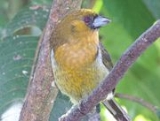
Prong-billed Barbet
Encyclopedia
The Prong-billed Barbet (Semnornis frantzii) is a distinctive, relatively large-billed bird
native to humid highland forest in Costa Rica
and western Panama
.
It often has been placed with the other barbets in the Capitonidae. However, DNA studies have confirmed that this arrangement is paraphyletic; New World Barbets are more closely related to toucan
s than they are to Old World
barbets. As a result, the barbet lineages are considered distinct families; the Prong-billed Barbet and the Toucan Barbet
now form a separate family, Semnornithidae.
The Prong-billed Barbet prefers cool, wet, moss-festooned mountain forest with large trees and adjacent habitat. Eats mainly fruits of trees and epiphytes, although it occasionally takes insects or flower petals. Flight is direct with rapid and buzzy wingbeats. The frequently heard and distinctive song is a throaty "cwa-cwa-cwa-cwa..." duet given by mated pair or two individuals in a group. Pairs nest March-May in an unlined woodpecker cavity, with 4-5 eggs in the nest.
The binomial commemorates the German naturalist Alexander von Frantzius
.
Bird
Birds are feathered, winged, bipedal, endothermic , egg-laying, vertebrate animals. Around 10,000 living species and 188 families makes them the most speciose class of tetrapod vertebrates. They inhabit ecosystems across the globe, from the Arctic to the Antarctic. Extant birds range in size from...
native to humid highland forest in Costa Rica
Costa Rica
Costa Rica , officially the Republic of Costa Rica is a multilingual, multiethnic and multicultural country in Central America, bordered by Nicaragua to the north, Panama to the southeast, the Pacific Ocean to the west and the Caribbean Sea to the east....
and western Panama
Panama
Panama , officially the Republic of Panama , is the southernmost country of Central America. Situated on the isthmus connecting North and South America, it is bordered by Costa Rica to the northwest, Colombia to the southeast, the Caribbean Sea to the north and the Pacific Ocean to the south. The...
.
It often has been placed with the other barbets in the Capitonidae. However, DNA studies have confirmed that this arrangement is paraphyletic; New World Barbets are more closely related to toucan
Toucan
Toucans are members of the family Ramphastidae of near passerine birds from the Neotropics. The family is most closely related to the American barbets. They are brightly marked and have large, often colorful bills. The family includes five genera and about forty different species...
s than they are to Old World
Old World
The Old World consists of those parts of the world known to classical antiquity and the European Middle Ages. It is used in the context of, and contrast with, the "New World" ....
barbets. As a result, the barbet lineages are considered distinct families; the Prong-billed Barbet and the Toucan Barbet
Toucan Barbet
left|250pxThe Toucan Barbet, Semnornis ramphastinus, is a distinctive bird found in humid forests growing on the west Andean slopes in north-western Ecuador and south-western Colombia. While it remains fairly common locally, it has declined due to habitat loss and trapping for the cage-bird...
now form a separate family, Semnornithidae.
The Prong-billed Barbet prefers cool, wet, moss-festooned mountain forest with large trees and adjacent habitat. Eats mainly fruits of trees and epiphytes, although it occasionally takes insects or flower petals. Flight is direct with rapid and buzzy wingbeats. The frequently heard and distinctive song is a throaty "cwa-cwa-cwa-cwa..." duet given by mated pair or two individuals in a group. Pairs nest March-May in an unlined woodpecker cavity, with 4-5 eggs in the nest.
The binomial commemorates the German naturalist Alexander von Frantzius
Alexander von Frantzius
Alexander von Frantzius was a German physician and naturalist.Frantzius collected natural history specimens in Brazil from 1849–1853 and Costa Rica in 1853, many of which he sent to Jean Cabanis at the Berlin Museum. He set up a pharmacy in San José in Costa Rica, employing José Castulo Zeledón as...
.

